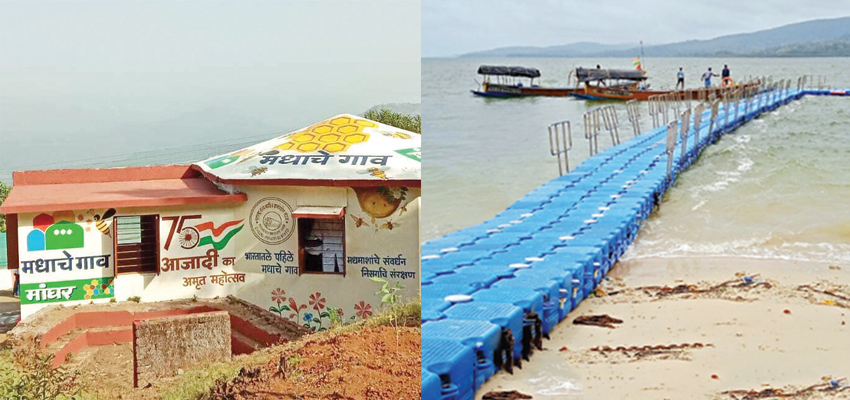
Corporate Citizen claps for the Maharashtra State Khadi & Village Industries Board’s (MSKVIB) initiative that has sustained the number of honeybees, established a strong apiary business, and has been aiding nature preservation, in and around Mahabaleshwar, Satara district.
MSKVIB, a Statutory Board under the Government of Maharashtra’s industry department, has been promoting beekeeping through its Directorate of Honey via the novel concept of ‘Honey Village’ or “Madhache Gaon”. The idea which took shape in May 2022, has been establishing end-to-end solutions in the apiary business. Located some 10 kilometres away from Mahabaleshwar, Manghar village in Satara became the first to be initiated as a ‘honey village’ with a Rs 50 lakh budget criteria. Most families living in and around Manghar have been involved in the bee-keeping business. Of the 100 village households, around 80 are involved in the apiary business, resulting in Mahabaleshwar and its satellite areas accounting for 28% of the total honey production in Maharashtra. The villagers have since collaborated with the government in setting up small industrial units for the collection and processing of honey and its by-products. It has thrown open an extended business ecosystem, where villagers are involved in making wax candles, and managing tea and snacks points, including garages, in an attempt to build a strong tourist eco-space under the Prime Minister Employment Generation Programme (PMEGP) and the Chief Minister Employment Generation Programme (CMEGP). The collective consciousness has to some extent combated the issues of declining numbers of bees, due to excessive urbanisation and the rampant use of chemical fertilisers and pesticides, affecting food security and biodiversity. It is known that honeybees potentially contribute to the United Nations’ Sustainable Development Goals (SDG), and MSKVIB’s approach is a baby step toward that goal. The apiary initiative has been restoring the ecosystem and also generating good revenue. The bee business has been envisaged to positively increase crop production, enhance organic farming and add greenery and growth to the lives of the ‘honey-villagers’, with scope to replicate the same across other locations.
Corporate Citizen slaps the continuing impacts of plastic waste accumulating in oceans and on beaches, affecting marine lives, which has now manifested in yet another hazard, that of the plastic-rock hybrid discovered in Andaman’s Aves island.
The rock is first such find from India, as recent research has been highlighting increased threats of plastic pollution in and around the Andaman and Nicobar Islands in the Bay of Bengal. Scientists have identified plastiglomerate on Aves Island, which might have been the result of burning plastic excessively close to the island; which later mixed with sand and rock fragments. Prasun Goswami, the lead author of the study, has explained that such rocks are formed when plastic in the form of burnt litter, mixes with conglomerates, such as sedimentary rocks, comprising of fragments like pebbles, sand, and silt. “If benthic organisms such as mussels or shrimp inadvertently ingest plastiglomerates, it will have a toxicological effect on them,” said Goswami. “This is the first find from India of Plastiglomerate. Laboratory analysis showed that it has two very commonly used plastic polymers – polyethylene and polyvinyl chloride, which was holding the smaller rock and sand particles to form a rock, approximately the size of ones found along railway tracks,” said Punyasloke Bhadury, a professor of biological sciences at Indian Institute of Science Education and Research (IISER), Kolkata. While the immediate impact of the plastic rock on marine species is yet to be studied, Bhadury, also a co-author of the study, is concerned that the new “stone” poses an imminent danger to the rich marine biodiversity of the region. Both Goswami and Bhadury believe that plastiglomerates or similar new forms of plastic pollution might exist in other areas along the Indian coasts. A research paper published in Current Science in 2019 revealed that plastic from around 10 Asian countries, including Malaysia, Indonesia, and Thailand was found in five islands in the Bay of Bengal archipelago. These man-made aggregates were first discovered at Kamilo Beach, Hawaii, and have been reported in the United States, Portugal, Canada, Peru, Indonesia and recently in India. These are early days as scientists continue to decipher the mysteries about the formation of such new forms of pollution hazards including their toxicity, degradation, and release of secondary pollutants like micro-plastics, nano-plastics and chemical additives. The answer is to seek more administrative and social awareness solutions where rampant burning of plastics has ironically been the primitive stance to rid the planet of plastic waste.